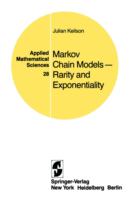Markov Chain Models - Rarity and Exponentiality
- List Price: $119.00
- Binding: Hardcover
- Publisher: Springer-Verlag
- Publish date: 04/01/1979
Description:
0. Introduction and Summary.- 1. Discrete Time Markov Chains; Reversibility in Time.- 1.00. Introduction.- 1.0. Notation, Transition Laws.- 1.1. Irreducibility, Aperiodicity, Ergodicity; Stationary Chains.- 1.2. Approach to Ergodicity; Spectral Structure, Perron-Romanovsky-Frobenius Theorem.- 1.3. Time-Reversible Chains.- 2. Markov Chains in Continuous Time; Uniformization; Reversibility.- 2.00. Introduction.- 2.0. Notation, Transition Laws; A Review.- 2.1. Uniformizable Chains -- A Bridge Between Discrete and Continuous Time Chains.- 2.2. Advantages and Prevalence of Uniformizable Chains.- 2.3. Ergodicity for Continuous Time Chains.- 2.4. Reversibility for Ergodic Markov Chains in Continuous Time.- 2.5. Prevalence of Time-Reversibility.- 3. More on Time-Reversibility; Potential Coefficients; Process Modification.- 3.00. Introduction.- 3.1. The Advantages of Time-Reversibility.- 3.2. The Spectral Representation.- 3.3. Potentials; Spectral Representation.- 3.4. More General Time-Reversible Chains.- 3.5. Process Modifications Preserving Reversibility.- 3.6. Replacement Processes.- 4. Potential Theory, Replacement, and Compensation.- 4.00. Introduction.- 4.1. The Green Potential.- 4.2. The Ergodic Distribution for a Replacement Process.- 4.3. The Compensation Method.- 4.4. Notation for the Homogeneous Random Walk.- 4.5. The Compensation Method Applied to the Homogeneous Random Walk Modified by Boundaries.- 4.6. Advantages of the Compensation Method. An Illustrative Example.- 4.7. Exploitation of the Structure of the Green Potential for the Homogeneous Random Walk.- 4.8. Similar Situations.- 5. Passage Time Densities in Birth-Death Processes; Distribution Structure.- 5.00. Introduction.- 5.1. Passage TimeDensities for Birth-Death Processes.- 5.2. Passage Time Moments for a Birth-Death Process.- 5.3. PF?, Complete Monotonicity, Log-Concavity and Log-Convexity.- 5.4. Complete Monotonicity and Log-Convexity.- 5.5. Complete Monotonicity in Time-Reversible Processes.- 5.6. Some Useful Inequalities for the Families CM and PF?.- 5.7. Log-Concavity and Strong Unimodality for Lattice Distributions.- 5.8. Preservation of Log-Concavity and Log-Convexity under Tail Summation and Integration.- 5.9. Relation of CM and PF? to IFR and DFR Classes in Reliability.- 6. Passage Times and Exit Times for More General Chains.- 6.00. Introduction.- 6.1. Passage Time Densities to a Set of States.- 6.2. Mean Passage Times to a Set via the Green Potential.- 6.3. Ruin Probabilities via the Green Potential.- 6.4. Ergodic Flow Rates in a Chain.- 6.5. Ergodic Exit Times, Ergodic Sojourn Times, and Quasi-Stationary Exit Times.- 6.6. The Quasi-Stationary Exit Time. A Limit Theorem.- 6.7. The Connection Between Exit Times and Sojourn Times. A Renewal Theorem.- 6.8. A Comparison of the Mean Ergodic Exit Time and Mean Ergodic Sojourn Time for Arbitrary Chains.- 6.9. Stochastic Ordering of Exit Times of Interest for Time-Reversible Chains.- 6.10. Superiority of the Exit Time as System Failure Time; Jitter.- 7. The Fundamental Matrix, and Allied Topics.- 7.00. Introduction.- 7.1. The Fundamental Matrix for Ergodic Chains.- 7.2. The Structure of the Fundamental Matrix for Time-Reversible Chains.- 7.3. Mean Failure Times and Ruin Probabilities for Systems with Independent Markov Components and More General Chains.- 7.4. Covariance and Spectral Density Structure for Time-Reversible Processes.- 7.5. A Central Limit Theorem.- 7.6. Regeneration Times andPassage Times-Their Relation For Arbitrary Chains.- 7.7. Passage to a Set with Two States.- 8. Rarity and Exponentiality.- 8.0. Introduction.- 8.1. Passage Time Density Structure for Finite Ergodic Chains; the Exponential Approximation.- 8.2. A Limit Theorem for Ergodic Regenerative Processes.- 8.3. Prototype Behavior: Birth-Death Processes; Strongly Stable Systems.- 8.4. Limiting Behavior of the Ergodic and Quasi-stationary Exit Time Densities and Sojourn Time Densities for Birth-Death Processes.- 8.5. Limit Behavior of Other Exit Times for More General Chains.- 8.6. Strongly Stable Chains, Jitter; Estimation of the Failure Time Needed for the Exponential Approximation.- 8.7. A Measure of Exponentiality in the Completely Monotone Class of Densities.- 8.8. An Error Bound for Departure from Exponentiality in the Completely Monotone Class.- 8.9. The Exponential Approximation for Time-Reversible Systems.- 8.10. A Relaxation Time of Interest.- 9. Stochastic Monotonicity.- 9.00. Introduction.- 9.1. Monotone Markov Matrices and Monotone Chains.- 9.2. Some Monotone Chains in Discrete Time.- 9.3. Monotone Chains in Continuous Time.- 9.4. Other Monotone Processes in Continuous Time.- References.
Expand description

Please Wait

